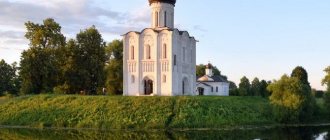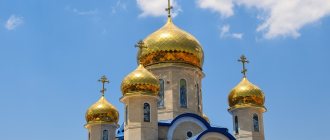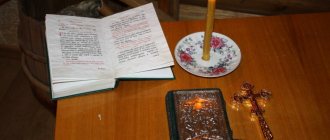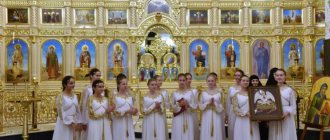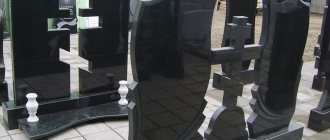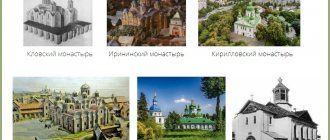Variety of dome shapes
The first dome structures appeared in ancient times, even before the advent of Christianity. These were the so-called belt domes, formed by a stepped vault. With this method of laying, each new layer protrudes above the previous one. A classic example is the ancient Treasury of Atreus at Mycenae.
Today there are several main types of domes known:
- Onion domes. They are distinguished by a convex shape, reminiscent of an onion, with a pointed apex. It is with these heads that most Orthodox churches are crowned, for example, St. Basil's Cathedral on Red Square in Moscow. Onion domes are also found in India and some Middle Eastern countries.
- Helmet-shaped domes. They are named so because they resemble the shape of an ancient Russian helmet. The width of such domes is no greater than their base. They were brought to Russian lands from the cultural and religious architecture of the Byzantine Empire and over time began to be replaced by bulbous ones. Today, helmet-shaped heads can be seen at the Assumption Cathedral in Moscow.
- Spherical domes - also comes from Byzantium. Unlike bulbous and helmet-shaped heads, the top of the spherical ones is not extended very upward. The single dome of the Church of the Dormition of the Virgin Mary in Kyiv has this shape.
- Polygonal domes – formed by several edges. Unlike other chapters with smooth transitions, polygonal domes have corners. The most famous representative with a dome structure of this form is the Cathedral of Santa Maria del Fiore in Florence.
- Saucer dome - the lowest of the domes, reminiscent of a spherical dome in a stripped down form. It is most characteristic of mosques in India, Iran, and Pakistan; it was used in ancient times in the construction of some Byzantine temples.
As you can see, the shapes of the domes are very diverse. This is due to different stages of development of architecture and the exchange of experience between cultures of different countries. In addition to the variety of shapes, domes have other differences.
True believers will certainly be interested in an article describing the Old Testament.
DOME
Stone K. in Dr. Rus were usually built on high light drums and covered with external domed roofs (metal on a wooden frame, wooden, covered with a scaly ploughshare, or tiled); t.o., rus. K. are actually 2-layer. The outer dome covering in Russia is called the head, the drum is called the neck. Sometimes the entire church wedding is called the chapter, which is essentially incorrect. The glavka is the name given to the small outer chamber above the small blind drum (not open to the interior of the temple). Heads of temples in the X-XII centuries. Usually the shape of the internal roof was repeated, that is, a roof covering made of lead or tiles was used. In the XII-XVII centuries. Helmet-shaped and bulbous heads became widespread. Due to the fragility of the material, Russian. There are no surviving examples of chapters dated earlier than the 17th century. The origins and time of appearance of onion heads are not fully clarified. The most balanced opinion seems to be the opinion of A.P. Novitsky about the evolution of hemispherical K. into helmet-shaped and then into bulbous (Novitsky. 1909). There is no reason to talk about the wide distribution of the onion-shaped heads earlier than the 16th century, but the coexistence of helmet-shaped and onion-shaped forms is likely from the 13th century. For Old Russian temples are characterized by a large number of K. - so-called. multi-headed, but the K. themselves are small, which lies in the mainstream of the Middle Byzantine. traditions (Stender. 1984). The origin of multi-domed churches is mysterious, but not purely Russian. phenomenon (see, for example, ts. Nea-Ekklesia in the K-field). The first stone church in Rus' (Church of the Mother of God, or Desyatinnaya, in Kyiv, 989-996, built by “Greek” craftsmen, destroyed in the 13th century) had 25 chapters (Tikhomirov. 1979).
Cathedral of St. Sophia in Kyiv. Reconstruction and modern appearance of St. Sophia Cathedral in Kyiv. Reconstruction and modern look
The monumental St. Sophia Cathedral in Kiev (c. 1037, built by an artel of Byzantine craftsmen under the Great Prince Yaroslav the Wise) is based on 13 K. It is a cross-domed 5-nave temple with a 3-sided bypass of the choirs in the naos and 2 rows of galleries surrounding pump on 3 sides. Naos is illuminated with 5 K on high light drums (the central drum is higher than the others) and 8 on lower ones. The side altars are illuminated by 2 pairs of east. K., 2nd tier of choirs - 4 pairs of western ones. Above the central cell rises the 12-sided drum of the main drum (diameter approx. 8 m). It rests on girth arches and sails on cross-shaped pillars. The rest of the pots (diameter approx. 4 m) are mounted on 8-sided drums. Another 2 light towers are located above 2 staircase towers asymmetrically located on the west; Thus, a total of 15 K. completed the pyramidal volumetric composition of the ancient cathedral. Komech explains the use of a large number of K. by the need to illuminate the space of the choirs (Komech. 1987. P. 196); The “prestige” of K., as a symbol of the architectural achievements of Byzantium, also played an important role. The original chapters have not been preserved, and according to the reconstructions of N. I. Kresalny, the cathedral had a lead roof covering, repeating the egg-shaped shape of the cathedral, with pronounced archivolts of the windows. In A. van Westerfeld's drawing of 1651, the chapters have a faceted helmet-like shape, and the central chapter is crowned with a small chapter on a blind neck, like a lantern in vestibule cabinets of the Renaissance. At the turn of the 17th and 18th centuries. pear-shaped domes (“baths”) were made, distorting the appearance of the temple. At the same time, new light signals appeared above the galleries. Nowadays the St. Sophia Cathedral has 19 rooms (including staircase towers and galleries).
Cathedral of St. Sophia in Novgorod. 1045–1052
Cathedral of St. Sophia in Novgorod. 1045–1052
In the same period as the St. Sophia Cathedral in Kyiv, the princely Spassky Cathedral was built in Chernigov (c. 1036) with 5 K. over the naos and one over the staircase tower. In Vel. St. Sophia Cathedral was erected in Novgorod (1045-1052, commissioned by Grand Prince Vladimir Yaroslavich), the architecture of which simplified the Kiev model, but the cross-domed 5-nave naos with choirs and galleries was completed 5 K., 6th, unusually wide K .rises above the staircase tower. The original roof covering was later replaced by onion domes, which were used during the restoration of the 20th century. gave way to helmet-shaped ones.
In Russian architecture appanage principalities of the 12th century. multi-domed churches are no longer so common (the princely St. Nicholas Cathedral in Vel. Novgorod, construction began in 1113, had 5 K., reconstructed in the 20th century; 3 K. of the Novgorod St. George Cathedral of the Yuryev Monastery, 1119-1130, located asymmetrically: large - above the central cell, 2 small ones - above the choir and staircase tower; Cathedral of St. John the Baptist of the Ioannovsky Monastery in Pskov, about 1140, crowned with 3 K.: one - above the central cell and 2 - symmetrically - to the west above the naos) . Single-domed churches were built much more often (Assumption Cathedral of the Kiev-Pechersk Monastery, 1073, not preserved; Boris and Gleb Cathedral in Chernigov, 1120-1123; Church of the Apostles Peter and Paul in Smolensk, mid-12th century; Assumption Cathedral in Vladimir-Volynsky, 1156-1160; Church of the Great Martyr George in St. Ladoga, mid-12th century; Church of Architect Michael (Svirskaya) in Smolensk, 1191-1194, with a dynamic pyramidal composition).
Cathedral in honor of the Dormition of St. Virgin Mary in Vladimir. 1158–1160
Cathedral in honor of the Dormition of St. Virgin Mary in Vladimir. 1158–1160
Temples of the Vladimir-Suzdal principality, built by order of the prince. Andrei Bogolyubsky and his brother Prince. Vsevolod Yurievich Big Nest by craftsmen sent by the Emperor. Frederick Barbarossa, combined the Byzantine composition. cross-domed churches with European style. novelists. The slender volumes of single-headed c are expressive. Intercession on the Nerl (c. 1166) and Demetrius Cathedral in Vladimir (1194-1197). Cathedral of the Assumption of the Most Holy. The Virgin Mary in Vladimir (1158-1160) was originally crowned with one crown with a helmet-shaped head. In con. XII century The 6-pillar cathedral was lined with galleries, for illumination of which 4 small lights were installed. the K. pair is larger than the 2 eastern ones. The drums of the chapters are decorated with elegant Romanesque arcature on the columns, complemented by a curb, towns and festoons of kokoshniks. The five-domed structure of the Assumption Cathedral in Vladimir, which formed by chance, due to historical reasons, began to be considered canonical for Russians. Orthodoxy and influenced the formation of the traditional type of cathedral 5-domed church for Russia.
During the era of the formation of the centralized Russian state, the Vladimir Assumption Cathedral was taken as a model during perestroika by order of the leader. book John III Vasilyevich Cathedral of the Assumption of the Most Holy. Virgin Mary in the Moscow Kremlin (1475-1479). Italian architect Aristotle Fioravanti created an innovative 6-pillar cathedral of the “chamber” type and crowned it with 5 hemispherical crowns on powerful light drums. The central drum (span approx. 9 m) is slightly larger and higher than the corner ones (approx. 7 m). All K. are covered with gilded onion-shaped domes (originally helmet-shaped, they were replaced in the 17th, 19th and early 20th centuries). A peculiarity of the location of the K. is that they are shifted to the east; Thus, the central K. is overshadowed by the pulpit, the 2 eastern ones are overshadowed by the deacon and altar, hidden behind the iconostasis, and the 2 western ones are overshadowed by the naos. The Assumption Cathedral of the Moscow Kremlin, as the main cathedral church of Russia, has become the most important iconographic example and one of the national architectural symbols. The Russians were built in his likeness. 5-domed cathedrals up to the middle. XVIII century, when this scheme organically fit into the new Baroque architecture.
The earliest imitation, although endowed with an individual appearance, is the cathedral of the arch. Michael in the Moscow Kremlin (1505-1508, architect Aleviz Novy), built in the forms of the Venetian Renaissance. The cross-domed church is topped with 5 K. on drums (the central one is larger), shifted to the east. Initially, the helmet-shaped heads were made of black polished tiles. In the 17th century tiles gave way to tinned iron. K.'s coverings changed after the fires, including in 1737 the central gilded onion dome was made, and the corner domes were painted green (later they became helmet-shaped silver).
Cathedral of the Assumption of the Most Holy. Virgin Mary in the Moscow Kremlin. 1475–1479
Cathedral of the Assumption of the Most Holy. Virgin Mary in the Moscow Kremlin. 1475–1479
Most of the large monastery and city cathedrals of the 16th century. repeat the image of the Assumption Cathedral of the Moscow Kremlin with 5 large onion domes on cylindrical drums (Assumption Cathedral in Rostov, 1508-1512, rebuilt in the 17th century; Transfiguration Cathedral of the Khutyn Monastery, 1515; Assumption Cathedral in Tikhvin, 1507-1515; Smolensk Cathedral Novodevichy Convent in Moscow, construction began around 1525, rebuilt in the 2nd half of the 16th century; Assumption Cathedral of the Trinity-Sergius Lavra, 1559-1585, with a central gilded dome and corner blue with gold stars; St. Sophia Cathedral in Vologda, 1568 -1570).
In the 16th century multi-domes developed in connection with the idea of a multi-altar church (there existed before that: for example, the Trinity Cathedral of Pskov, 1365-1367, had at least 7 chapters over 7 thrones), and during the reign of Ivan the Terrible it acquired a new ideological meaning - the sanctification of historical events through the heavenly protection of saints (Batalov. 1993). Thus, the royal court Annunciation Cathedral of the Moscow Kremlin (1484-1489, Pskov masters), originally 3-domed (one chapter above the pulpit and 2 above the altar), was reconstructed at the behest of the tsar in 1564-1566. received 2 more cupolas on blind drums from the west and 4 cupolas above the aisle tents; The 9 onion-shaped domes and the roof of the temple were completely covered with gilding.
Cathedral of the Intercession on the Moat. 1555–1561
Cathedral of the Intercession on the Moat. 1555–1561
The Cathedral of the Intercession on the Moat (1555-1561, architects Barma and Postnik Yakovlev) most clearly embodied the image of a multi-domed, multi-throne church. Temple-monument to Russian victories. troops over the Kazan and Astrakhan khanates arose on the site of the ancient c. Holy Trinity. During the hostilities, 7 wooden temples were erected around this temple, each of which celebrated the day of another victory. After the end of the war, it was decided to build a large stone centric cathedral with a quadrifolium-shaped plan, composed of 9 tower-like pillars. The central pillar under a high tent with a gilded dome at the top (total height 65 m, internal space 46 m, span 8 m) is surrounded by 8 churches: in the corners there are quadrangles with powerful onion domes on cylindrical drums, and at the cardinal points there are higher 8-sided ones towers, also with large onion-shaped heads. The iron polychrome domes of the 8 side churches have a variety of bizarre shapes with spiral stripes, “crenate” friezes or “diamond” edges. At the base of the central tent there were 8 small gilded decorative domes, which were later lost; Thus, initially the cathedral was crowned with 17 chapters (now 10). The Intercession Cathedral was rebuilt several times and acquired picturesque features of asymmetry. In 1588, the chapel of the blzh was added from the south. Vasily of Moscow with a figured onion dome, and in 1672 - a chapel of the blzh. John of Moscow. In 1680, the open walkways of the 2nd tier were covered with vaults and porches were added. At the same time, the chamber belfry (late 16th century) near the southeast. corner of the cathedral was replaced by a hipped bell tower. The original form of the domes of the Intercession Cathedral is unknown. According to the reconstructions of N. N. Sobolev and B. N. von Eding, the cathedral was crowned with flattened helmet-shaped gilded domes with a keeled point (like the dome of the Church of the Ascension in Kolomenskoye, 1532, architect Petrok Maloy). For the first time, onion-shaped figured heads “with pink samples and upholstered with German iron” were mentioned in 1584-1585. Afterwards the chapters burned several times (1559, 1626, 1668, 1672, 1737) and were replaced, but their shape was preserved. The multi-colored coloring was first mentioned in 1654, but it is assumed that it was intended originally. The last time the coloring was updated was in 1848. The Church of the Intercession on the Moat, with its many domes and bizarre pointed silhouette, reflected the generalized image of the Russian people. temples and is the main architectural symbol of Russia. With the combination of many stones and a central tent, it resembles the Church of the Holy Sepulcher in Jerusalem and symbolizes the Heavenly City. Despite the bright national identity, researchers see Eastern and European influences in the architecture of the Church of the Intercession on the Moat. The shape of the chapters could be inspired by eastern models (the Dome of the Rock in Jerusalem, the Shahi-Zinda mausoleums in Samarkand), and the centric plan in the form of a quadrifolium and the tower are similar to Bramante's design for the Cathedral of St. Peter's in the Vatican. As a prototype of the cathedral, A.L. Batalov cites the design of the temple of S. Serlio (Serlio. 1600. Fol. 212-213). Dr. possible prototype - Romanesque-Gothic 5-tower building. Virgin Mary in Kalundborg, Denmark (c. 1200).
Church of the Holy Trinity in Khoroshev, Moscow. 1596–1598
Church of the Holy Trinity in Khoroshev, Moscow. 1596–1598
The Cathedral of the Intercession on the Moat influenced the formation of the type of multi-volume churches (the 5-domed Cathedral of Saints Boris and Gleb in Staritsa, not preserved; the Church of St. John the Baptist in Dyakovo, both - 2nd half of the 16th century; the 5-domed Transfiguration Cathedral of the Solovetsky Monastery (1558-1566), where initially a high tent rose above the middle of the crossroads; during the restoration of the 20th century, wooden domes, typical of rural Russia, covered with scaly ploughshares, were recreated).
In the so-called In Godunov's architecture, onion domes became widespread (the Kremlin bell tower of Ivan the Great, built on the upper tier with St. John the Climacus, was crowned with a large gilded onion dome). However, the churches in Godunov’s estates ended with helmet-shaped domes on elegant drums, often mounted on a hill of kokoshniks (Church of the Holy Trinity in Khoroshev, Moscow, 1596-1598; Church of the Transfiguration in B. Vyazemy, Odintsovo district, Moscow region, ca. 1590 , the central head was crowned).
Cathedral of the Resurrection of Christ in the New Jerusalem Resurrection Monastery. 1658–1666, 1679–1685, 1756-1761 Photo. Con. XIX century
Cathedral of the Resurrection of Christ in the New Jerusalem Resurrection Monastery. 1658–1666, 1679–1685, 1756-1761 Photo. Con. XIX century
In the 17th century The dominant phenomenon of domed architecture was the construction of large 6-pillar, 5-domed cathedrals with large onion domes (Preobrazhensky Cathedral of the Novospassky Monastery in Moscow, 1645-1649; Iversky Cathedral of the Valdai Monastery, 1653-1656, etc.). The 4-pillar Intercession Cathedral in Izmailovo, Moscow (1671-1679) is original, with a rational centric composition and rich tiled decoration. At the end of the century, 5-domed cathedrals acquired the features of a new, Naryshkin style (the Assumption Cathedral of the Joseph Volokolamsk Monastery, 1688-1696, with tiled details and faceted drums of the domes; the Assumption Cathedral in Ryazan, 1693-1699, with a central golden dome and corner blue with stars).
At the same time, the decorativeness of architecture increased: tradition. five-domed or multi-domed could be an external attribute that did not correspond to the design of the temple. Characteristic is the Verkhospassky Cathedral at the Terem Palace of the Moscow Kremlin (“The Savior behind the Golden Lattice”, 1635-1636, architects Bazhen Ogurtsov and others, 1679-1680, chapters - 1682, architect O. D. Startsev), crowned with 11 gilded cupolas on the blind drums, picturesquely arranged in a checkerboard pattern. All R. XVII century “false five-domed” became widespread, when the pillarless quadrangle of the temple under a closed vault is completed with a slide of kokoshniks and 5 blind drums (sometimes a central light one) with onion domes (Church of the Holy Trinity in Nikitniki, 1631-1634 or mid-17th century (?) , with a five-domed quadrangle and single-domed chapels; Church of St. Nicholas on Bersenevka, 1656-1657; Church of the Annunciation in Taininsky (now Mytishchi, Moscow region), 1675-1677; Church of the Tikhvin Icon of the Mother of God in Alekseevsky, now Moscow, consecrated in 1680; the last 2 were ordered by Tsar Alexei Mikhailovich). Unique c. Holy Trinity in Ostankino, Moscow (1678-1683), where all 5 miniature drums are open to the interior of the quadrangle and only the drums of the aisles are blind.
Church in honor of the Nativity of St. Our Lady of Kozelets. 1752–1763
Church in honor of the Nativity of St. Our Lady of Kozelets. 1752–1763
In the 17th century stone construction flourished in Yaroslavl, the 5-domed churches of which were famous for their expressive “heaving” bulbous domes, usually covered with a ploughshare or iron scales (C. Prophet Elijah, 1647-1650; churches of St. John Chrysostom, 1649-1654, 1680, and Vladimirskaya, 1669, in Korovniki; Church of St. John the Baptist in Tolchkovo, 1671-1687, with 15 chapters: 5 above the temple and 2 above the chapels).
The largest architectural project in Russia 2nd half. XVII century there was the New Jerusalem Resurrection Monastery in Istra, near Moscow, commissioned by Patriarch Nikon. The grandiose Resurrection Cathedral (1658-1666, 1679-1685, reconstructed in 1756-1761, architects B.F. Rastrelli, K.I. Blank) combined the composition of the Church of the Holy Sepulcher in Jerusalem and the multi-domed structure traditional for Russia. Above the central crossroads rises a large tower (span 8.5 m) on a light drum with a gilded onion-shaped head. Another 5 small onion-shaped domes on faceted drums illuminate the altar chapels of the cathedral, and the 6th, larger one, illuminates the underground church. The cathedral has 2 asymmetrical high-rise dominants. The main place is occupied by the tent over the rotunda of the Holy Sepulcher (originally stone under a helmet-shaped dome, collapsed in 1723; replaced in 1756-1761 by a wooden one with an ornate onion-shaped gilded dome; blown up by German troops in 1941, recreated at the turn of the 20th and 21st centuries, span approx. 20 m, total height with cross 60 m). From the south On the sides there is a 7-tier bell tower, topped with an onion dome (the original dome was a tent-roofed one).
Church in honor of the Icon of the Mother of God “The Sign” in Dubrovitsy, Moscow region. 1690–1704
Church in honor of the Icon of the Mother of God “The Sign” in Dubrovitsy, Moscow region. 1690–1704
On the territory of modern Ukraine in mid. XVII century A specific typology of domed churches developed. Centric compositions with a plan in the form of a quadrifolium and five domes according to the cardinal points were popular here (the Church of the Savior on Berestov, foundation 1113-1125, recreated from ruins in new forms by Metropolitan Peter Mogila in 1640-1642; St. George's Cathedral of the Vydubitsky Monastery, 1696-1696 1701, - both in Kiev; St. Nicholas Cathedral in Nizhyn, Chernigov region, 1658, with elaborate pear-shaped domes on 8-sided drums; Transfiguration Cathedral in Izyum, Kharkov region, 1684, with 2-tier 8-sided domes drums). Also typical for Ukraine were 3-part, or “three-bath”, churches (the 2-story Intercession Cathedral in Kharkov, 1689, with a pyramidal composition of 3-tier octagons aligned along the “west-east” axis). The type of 5-domed longitudinal temples is unusual. The eastern part of the building had a large dome above the middle cross and 2 small domes above the altar; on the west. the facade had 2 more chapters, similar to 2 towers on the facades of Catholic churches (the Cathedral of the Fraternal Monastery, 1690-1693, and St. Nicholas Military Cathedral, 1696, both in Kiev, architect Startsev, not preserved; Trinity Cathedral of the Trinity-Ilyinsky monastery in Chernigov, 1679-1695; Transfiguration Cathedral of the Mgarsky monastery in Poltava region, 1684-1692). The Cathedral of the Exaltation of the Cross in Poltava (1699-1709) represents a 7-domed version of the same type with five domes according to the cardinal points to the east. parts and 2 chapters in the west. The basis of the pear-shaped domes, or “baths,” alternating wide “abysses” and narrow “creases,” is the image of a vestibule with a lantern like the Cathedral of St. Peter's in the Vatican. This form came to Ukraine through Poland and South. Germany, where complex forms of domed roofs were common.
Developed at the turn of the 17th and 18th centuries. in Moscow, the Naryshkin style combined Ukrainian, German. and Polish influence with the traditions of Moscow architecture and gave rise to many new forms, which was reflected in the structure of the building and its chapters. The main structural form was the light octagon, which replaced the cylindrical drum. An octagon on a quadrangle could end with a closed vault, on which another one or several were placed. smaller octagons one above the other and a dome - this is how a tiered composition was obtained (Church of St. Tsarevich Joasaph in Izmailovo, 1678, “three-bath” superstructure 1687-1688, not preserved; Church of the Holy Trinity in Trinity-Lykovo, 1698-1703, with a ringing tier above the light octagon). Centric temples with a 4-petal plan and Ukrainian style became widespread. five domes according to the countries of the world (New Cathedral of the Don Monastery, 1684-1698, with traditional Moscow onion domes on round light drums; Church of the Intercession in Fili, 1690-1693, with a tiered composition “octagon on a quadrangle” under ringing, lowered exedra and faceted bulbous heads on blind octagons). At the same time traditional. the Moscow five-domed church was interpreted in a new way (the gate church of the Transfiguration of the Novodevichy Monastery, 1687-1688, completed with Ukrainizing “baths”; the church of St. Nicholas “Big Cross” on Ilyinka, late 17th century, not preserved, with relief stars on bulbous heads). T.n. Stroganov churches combined the five-domed “Ukrainian style” (Cathedral of the Nativity in Nizhny Novgorod, ca. 1700) or “Moscow style” (Cathedral of the Vvedensky Monastery in Solvychegodsk, 1689-1693) with innovative designs of pillarless quadrangles.
There were exotic options for completions: for example, in c. Dormition on Pokrovka (1695-1706, not preserved) the light octagon on the quadrangle was crowned with a smaller octagon with a pear-shaped head, and in the corners there were 4 small domes on blind necks; at the same time, from the east and west, the composition was complicated by 2 light octets with domes on faceted necks. Znamenskaya c. in Dubrovitsy, Moscow region. (1690-1704), the only one among the Russians. temples, is distinguished by its skyward centric composition, 12-petal plan and central pillar topped with an openwork gilded crown. Unusual architectural hybrids include an octagon on a quadrangle with a “false five-domed structure” (Trinity Cathedral in Verkhoturye, Sverdlovsk region, 1703-1709).
Wooden architecture at the turn of the 17th and 18th centuries. also gave rise to many bizarre compositions. A masterpiece of architecture of the Russian North is the complex of churches in the Kizhi churchyard on Lake Onega. Summer c. Transfiguration (1714) is crowned with 22 onion-shaped domes on graceful blind necks, mounted on barrel-shaped roofs. The 21 domes are arranged in steps, forming a cross in plan; the 22nd dome overshadows the altar.
The meaning of the color of the domes
A distinctive feature of Orthodox churches is the richness of the color palette of their “tops”. The use of a certain color not only decorates the appearance of the church, but also carries a sacred meaning.
For example:
- gilded the vault symbolizes the divine glory and greatness of religion; usually the main temple of the city was crowned with golden domes;
- blue domes are erected in the name of the Virgin Mary, some of them are decorated with stars, as a reminder of the birth of Jesus Christ and the Star of Bethlehem, which marked this historical event with its bright appearance in the sky;
- blue the color of the temple titles, like blue, personifies the purity and spirituality of the heavenly world;
- green the color in Orthodoxy is the color of the Holy Spirit, and the green domes indicate that the temple is dedicated to the Holy Trinity or one of the revered saints;
- black color in the Orthodox tradition is the color of monasticism, which is why black domes are found in many monasteries.
The variety of colors is what attracts Russian churches and what makes each church unique and inimitable. What other information about the temple can be obtained by knowing about the features of its chapters?
The outer part of the church dome.
Of these six chapters, two chapters have their opposites in the chapters mentioned earlier - this is the chapter about the detractor, which is the opposite of the chapter about the helper friend, and the chapter about rupture, which is the opposite of the chapter about unity.
The deadline for printing the book was already approaching, and I still continued to figure out what sections the second chapter is divided into, what the ladder of yoga consists of, what elements the third and fourth chapters consist of, where is the connection between chapters seven and eight, what is the secret of the first verses of the eighth chapter and the last verses of the ninth, how to correctly understand the sequence described in the twelfth chapter, how to understand the complex verses and comments in the thirteenth chapter and the last section in the fifteenth, what elements the sixteenth and seventeenth chapters consist of, how they are connected and what structure the eighteenth chapter has.
Particular attention is paid to the corporate form of the enterprise, the separation of ownership from management that arises with it and related problems, as well as the mechanisms of control of managers. Chapter 6 is devoted to the economic theory of the state, and Chapter 7 examines issues of institutional dynamics and the dependence of society's institutions on the previous path of development. The appendices to some chapters address issues that are beyond the scope of the institutional economics course, but which are necessary for understanding the problems being studied.
... includes: stopping a vehicle (Chapter 4 of our book) or a pedestrian; checking ... vehicle markings and license plates (Chapter 7); checking the documents that the driver must ... have with him (Chapter 6); issuing a ruling to initiate a case regarding...; drawing up a protocol on an administrative offense (chapters 9 and 13) and issuing a decision on administrative ...; suspension from driving (Chapter 7); examination for the state of alcoholic intoxication ... examination of the state of intoxication (Chapter 12); confiscation of a driver's license (Chapter 9); prohibition of operation of a vehicle ... vehicle and its detention (Chapter 11); inspection of the vehicle and cargo ... and inspection of the vehicle (Chapter 7); personal search and search of things located ... in the possession of an individual (Chapter 7); seizure of things and documents and seizure of things... (Chapter 7); delivery, administrative detention and detention (Chapter 7); on-site visit...
The first of them is a real chapter about signs of love, then a chapter that talks about those who fell in love in a dream, then a chapter that talks about those who fell in love by description, then a chapter that talks about those who fell in love at first sight, then a chapter that talks about those whose love becomes true only after a long period of time, then a chapter on hinting by word, then a chapter on pointing with the eye, then a chapter on exchanging messages, then a chapter on the mediator.
Finally, the final chapters describe additional types of ADO.NET-based projects: ASP.NET-based Web applications (Chapter 11, “Web Forms: ASP.NET-Based Applications for Working with Databases”), and Web-based applications. services and middleware (Chapter 12, “Web Services and Middleware”).
The value of the number of domes
Each individual dome is already a work of art. If you take all the domes into account at once, even more meaning will emerge. After all, their number is not accidental and has great symbolism. Thus, a single dome on the temple personifies the One God. If the church has domes:
- two, this symbolizes the duality of the nature of Christ - human and angelic;
- three, personifies the Holy Trinity;
Blue and Golden Domes of Assumption Cathedral in Holy Trinity Monastery of St. Sergius
- five, the four evangelist apostles are personified with the Savior;
- seven, symbolizes the seven sacraments,
- thirteen, personifies the Savior and the 12 apostles;
- thirty three, dedicated to the 33 years of the earthly life of Jesus Christ.
Thus, the domes can be called a kind of “passport” of the temple. From it you can learn about the history of the church, who it is dedicated to and what meaning it wants to convey to people. Having dealt with the symbolism of church domes, let’s move on to the technical part, namely their production and design.
How domes are made
A dome is a very “useful” structure that is highly valued in architecture. The use of this structure allows you to cover large spaces with minimal use of additional supports. A modern church dome typically consists of a metal frame, fiberglass shell, and roof cladding.
Today, only the name remains of most golden domes. Due to its high cost and fragility, natural gold is used less and less. It was replaced by titanium nitride, which is used to coat stainless steel plates. This material is not much inferior to gold in beauty, but is superior in reliability and ease of processing. Titanium nitride-coated panels are attached to the dome support, after which it rises to the top.
There is no doubt that dome building is a unique craft. It combines the genius of architectural thought and the depth of biblical implications.
